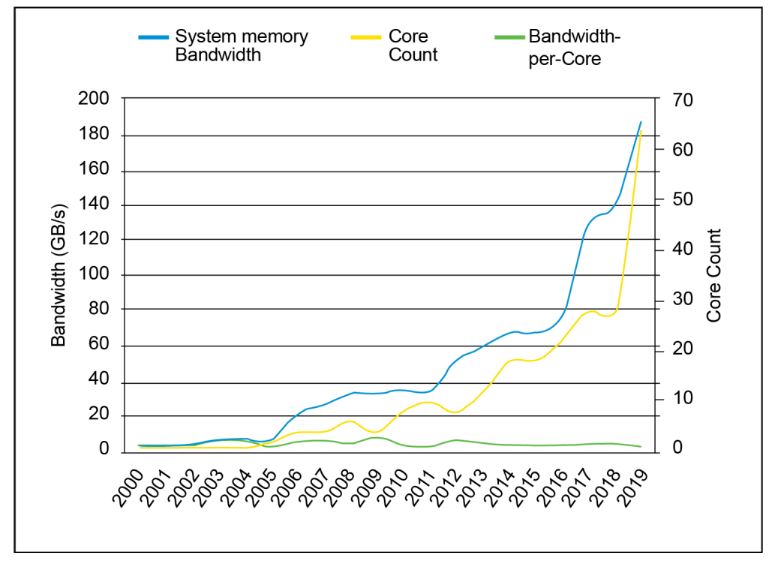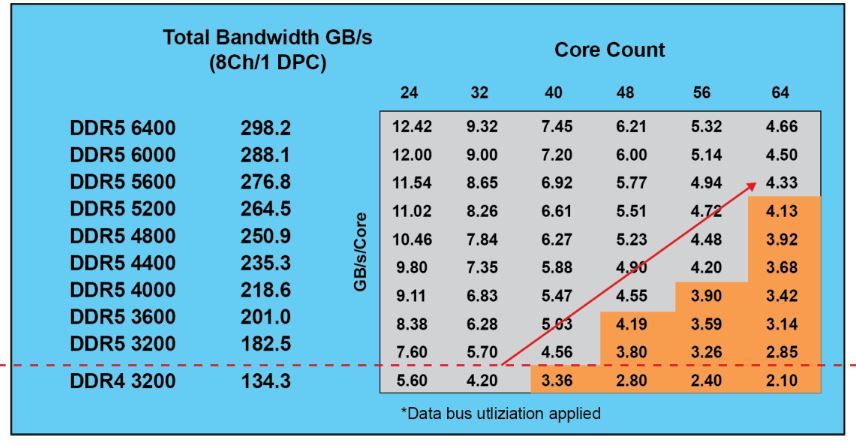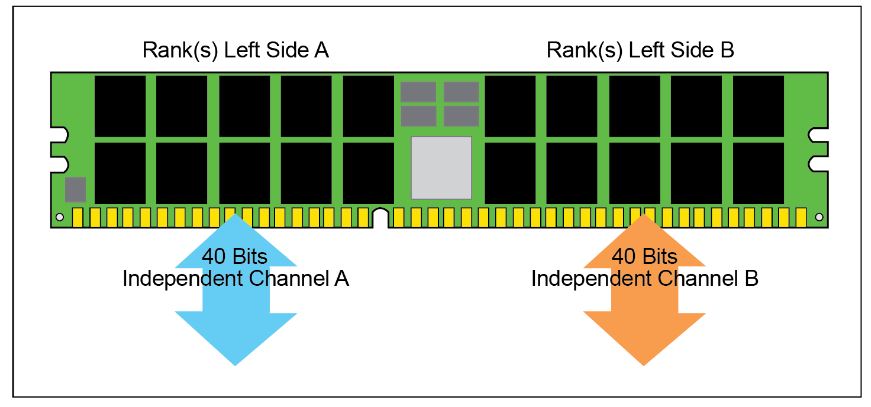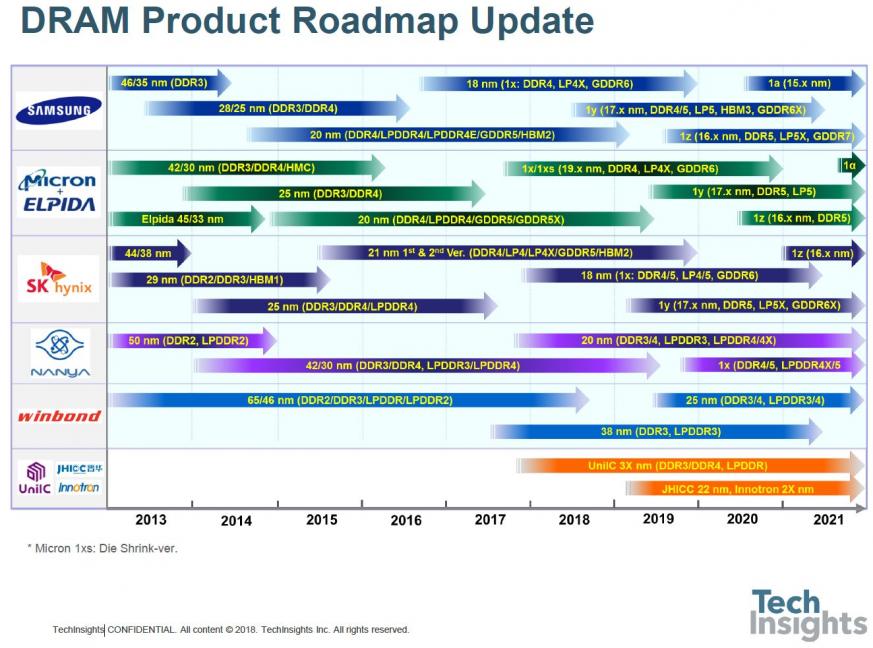What We Know About DDR5 So Far
Double Data Rate 5 (DDR5) is the next-generation standard for random-access memory (RAM). The new specification promises to bring chips that have much higher performance than the existing DDR4 modules, as well as lower power consumption. But what does that mean for desktop PCs? Let's take a look at what we know so far.
Why We Need DDR5 RAM
With the launch of AMD’s first-generation Ryzen processors, a new Core War began. AMD delivered quad-core/eight-thread processors at mid-range and eight-core/16-threads CPUs at the high-end for mainstream PC consumers, which was just about double what Intel had been offering for years in those ranges.
With the third-generation Ryzen processors, AMD has increased the core count by another 50%, pushing six-core chips at mid-range and 12-cores at the high-end. Intel has also been forced to respond with an increase in the number of cores for its own processors, although Intel hasn’t been nearly as aggressive as AMD.
In less than three years we went from four cores being just about the highest number most gamers or regular PC users could expect in their computers to three times as many. What all of this means is that we’re going need to drastically increase our memory bandwidth per core, too, if our PCs are going to keep up with AMD and Intel’s core war.
As we can see from Micron’s chart above, bandwidth per core has remained relatively stable since the early 2000s. However, bandwidth per core has started to decline since last year.
DDR5 Performance
DDR5 designs promise to arrive on the market with double the density as well as double the performance of the first-generation DDR4 modules.
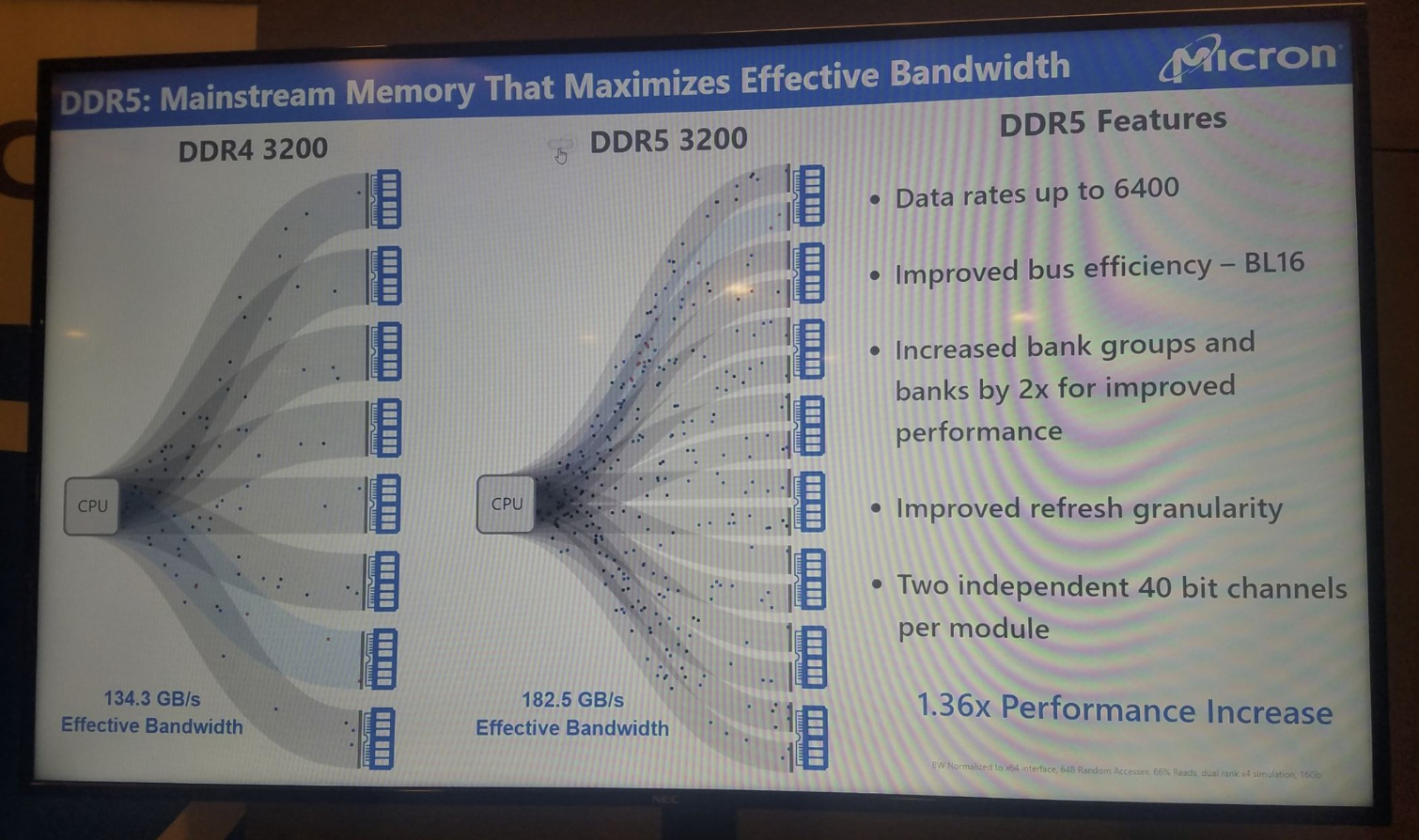
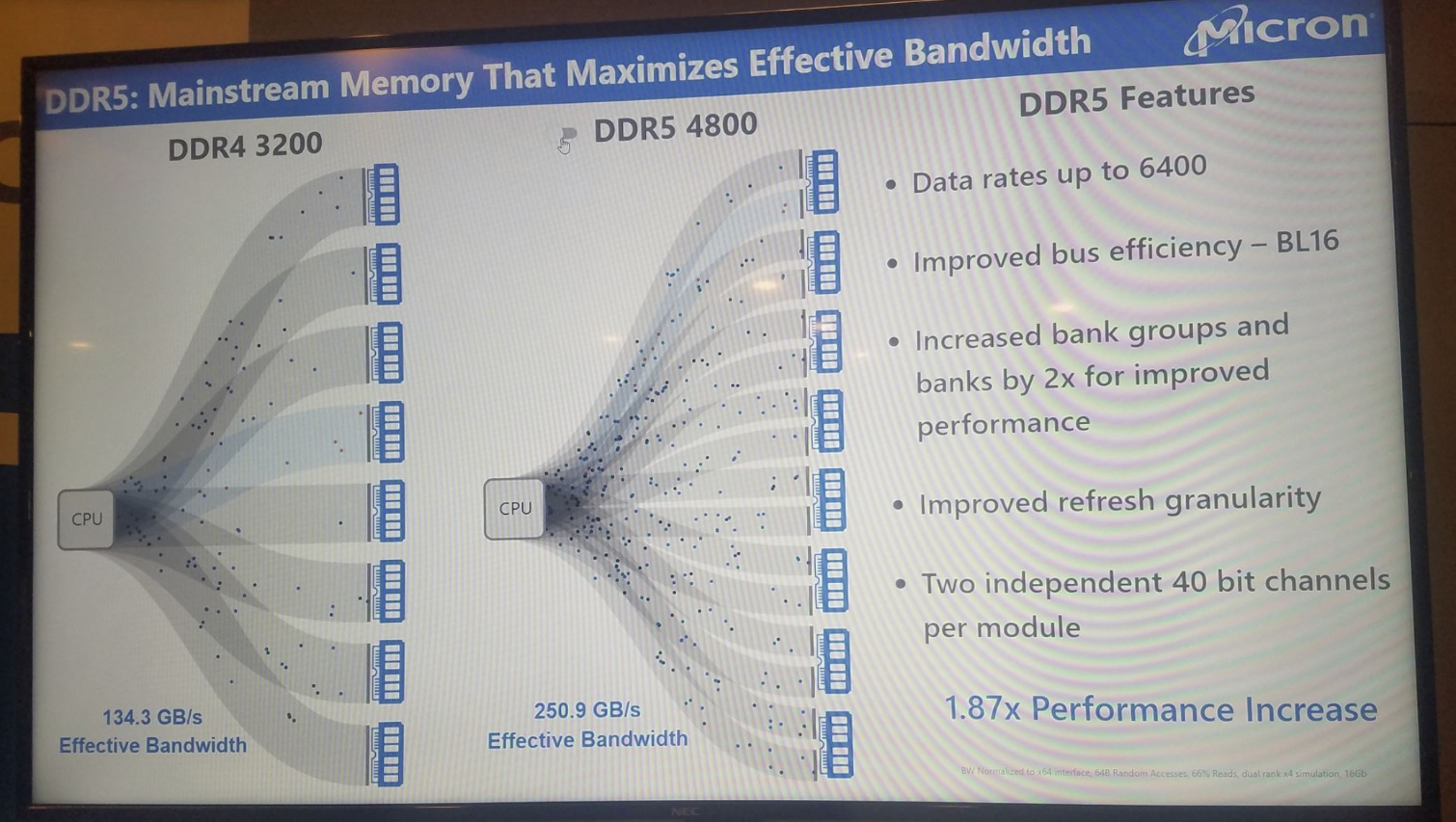
Image Credits: David Schor / WikiChip
Get Tom's Hardware's best news and in-depth reviews, straight to your inbox.
DDR5-3200 RAM will see an increase of 1.36x in bandwidth compared to DDR4-3200. However, DRAM chips are expected to ship with a bandwidth of 4800MT/s, or 1.87x that of DDR4-3200 RAM. The official upper limit for the DDR5 RAM standard is 6400MT/s, but some designs may be able to push that further through overclocking.
| Memory Type | Release Year | Bandwidth | Pins per Ch | Voltage (V) | Prefetch |
|---|---|---|---|---|---|
| SDR | 1993 | 1.6 GB/s | 168 | 3.3 | 1n |
| DDR | 2000 | 3.2 GB/s | 184 | 2.5/2.6 | 2n |
| DDR2 | 2003 | 8.5 GB/s | 240 | 1.8 | 4n |
| DDR3 | 2007 | 17 GB/s | 240 | 1.35/1.5 | 8n |
| DDR4 | 2014 | 25.6 GB/s | 380 | 1.2 | 8n |
| DDR5 | 2019 | 32GB/s | 380 | 1.1 | 8/16n |
| HBM2 | 2016 | 307 GB/s | 2860 | 1.25/1.35 | 16n |
| GDDR6 | 2016 | 72 GB/s | 180 | 1.35 | 16n |
SK Hynix has been working on DDR5 modules that can deliver 16Gb (2GB) capacity per chip. The company lowered voltage from 1.2V to 1.1V, which combined with the usage of its 1Ynm process, reduced power consumption compared to the company’s DDR4 modules. The module offers up to 6.4Gb/s of throughput for each pin.
Other benefits of DDR5 RAM include two independent 40-bit channels per module, improved command bus efficiency, improved refresh schemes and an increased bank group for additional performance.
Features Enabling High-Bandwidth DDR5 RAM
According to Micron, DDR5 will use a completely overhauled architecture compared to DDR4, with a focus on increasing bandwidth. A number of key features enable this increase in bandwidth. The most important is that DDR5 can increase the data rates from 3,200 MTps to 6,400 MTps. This data rate increase alone should more than keep up with potential future processors with even more cores.
The new DDR5 RAM standard also includes other new protocol features that are not related to the data rate transfers, but can still increase overall bandwidth. For instance, DDR5 DIMMs will support two 40-bit (32-bit + ECC) independent channels.
The new default burst length of 16 (BL16) in DDR5 RAM allows a single burst to access 64B of data, which is the typical CPU cache line size, using only one of the two independent channels or half the DIMM. This feature should provide a significant improvement in concurrency and effectively move us from the 8-channel memory systems we know today to a 16-channel system.
DDR5 also doubles the number of bank groups (BGs) compared to DDR4, while keeping the number of banks per BG the same. This means that the total number of banks will be double that of DDR4. This helps controllers avoid performance degradation associated with sequential memory accesses within the same bank. All of these features and more point to how significant of an upgrade DDR5 will be compared to DDR4.
First DDR5 Products to Ship In 2019
In March 2017, JEDEC, the group developing the DDR standard as well as other memory and storage standards, announced that it would release the DDR5 specification in 2018. In November 2018, SK Hynix announced the world’s first DDR5-compliant RAM module, which the company initially said would arrive in 2020.
However, since then SK Hynix has said that it will release a DDR5 module by the end of 2019. Samsung and Micron have also previously said they would release DDR5 memory modules, but those may not be fully standard-compliant.
SK Hynix predicted that DDR5 module sales would represent 25% of the RAM market in 2020 and 44% in 2021. The adoption of DDR5 RAM may be even faster in the mobile and data center markets. Smartphone makers (including Samsung) will want to outclass the competition with faster DDR5 LPDRAM, while data center customers will be seeking to satisfy their ever-increasing bandwidth needs. Meanwhile, we're still waiting for word on a firm arrival date for DDR5 for desktop PC, but this will likely hinge on AMD and Intel offering support on mainstream motherboards. Unfortunately, there have been no signs of DDR5 enablement from either company yet.
MORE: Best RAM
Lucian Armasu is a Contributing Writer for Tom's Hardware US. He covers software news and the issues surrounding privacy and security.
-
TJ Hooker Reply
All other information I've seen indicates that the only source of increased bandwidth for DDR5 is from increased transfer rate, such that if DDR5 and DDR4 were running at same speed they'd have the same bandwidth. As has been the case going back all the way to the original DDR SDRAM. Is there just lots of typos/bad math in this article, or is there some other factor increasing the bandwidth of DDR5 compared to DDR4 other than transfer rate?Lucian Armasu said:DDR5-3200 RAM will see an increase of 1.36x in bandwidth compared to DDR4-3200. However, DRAM chips are expected to ship with a bandwidth of 4800MT/s, or 1.87x that of DDR4-3200 RAM.
The DDR5 RAM chips are expected to start at 4800MT/s, which would be a 1.87x increase in bandwidth compared to DDR4-3200 RAM. The DDR5 standard has an official limit of 6400MT/s, but we may see some memory companies push that further. -
XaveT <nit-picky>Reply
The article has some repeated text, can we get a bit of a clean-up? I only mention it because it was distracting trying to read through it.
</nit-picky> -
Xajel ReplyTJ Hooker said:All other information I've seen indicates that the only source of increased bandwidth for DDR5 is from increased transfer rate, such that if DDR5 and DDR4 were running at same speed they'd have the same bandwidth. As has been the case going back all the way to the original DDR SDRAM. Is there just lots of typos/bad math in this article, or is there some other factor increasing the bandwidth of DDR5 compared to DDR4 other than transfer rate?
DDR5 is rumoured to have 16n prefetch mode, which if it happens means at the same clock DDR5 should be twice as fast as DDR4.
It's the same as what DDR3 brought compared to DDR2 which also doubled it compared to DDR.
DDR3 and DDR4 both had 8n prefetch, DDR5 is still unconfirmed, some says it has 8n like DDR3 & 4. While some says it has 16n, like GDDR5 & HBM2. -
jimmysmitty ReplyA 32GB stick of DDR5 RAM should have the same density as a 16GB DDR4 stick while delivering roughly twice the performance.
This line doesn't make any sense. If a it is a 32GB stick, although a different pin layout most likely, it is twice a s dense as a 16GB DDR4 stick.
Now if you are talking about the number of DRAM modules on the stick then I could see it being true if its has 16 per stick (8 per side). -
Paul Alcorn ReplyTJ Hooker said:All other information I've seen indicates that the only source of increased bandwidth for DDR5 is from increased transfer rate, such that if DDR5 and DDR4 were running at same speed they'd have the same bandwidth. As has been the case going back all the way to the original DDR SDRAM. Is there just lots of typos/bad math in this article, or is there some other factor increasing the bandwidth of DDR5 compared to DDR4 other than transfer rate?
Here's a bit more info on the matter 1116168728046002176View: https://twitter.com/david_schor/status/1116168728046002176 -
TJ Hooker Reply
This doesn't really make sense either. If doubling prefetch doubled bandwidth for the same transfer rate, why does DDR2 have the same bandwidth as DDR if they're both running at the same speed? Same for DDR3 vs DDR2. Same for GDDR5X vs GDDR5. Also, even if increasing prefetch did increase bandwidth at the same transfer rate, according to the article DDR5 only has 36% more bandwidth than DDR4 at the same transfer rate, not 100%:Xajel said:DDR5 is rumoured to have 16n prefetch mode, which if it happens means at the same clock DDR5 should be twice as fast as DDR4.
It's the same as what DDR3 brought compared to DDR2 which also doubled it compared to DDR.
DDR3 and DDR4 both had 8n prefetch, DDR5 is still unconfirmed, some says it has 8n like DDR3 & 4. While some says it has 16n, like GDDR5 & HBM2.
DDR5-3200 RAM will see an increase of 1.36x in bandwidth compared to DDR4-3200.
Edit: I should clarify that when I say bandwidth I'm talking about theoretical max bandwidth. -
vaughn2k In March 2017, JEDEC, the group developing the DDR standard as well as other memory and storage standards, announced that it would release the DDR5 specification in 2018Reply
This is from the JEDEC Specification JESD21-C Configurations for Solid State Memories maintained by JC41 JEDEC Committee - which is also the committee developing the DDR standard.
JEDEC Organization, as a whole, is not only responsible for memory standard, but all semiconductor, and microelectronics standardization for interoperability. -
epobirs The next generation of Sony and Microsoft game consoles will be likely early adopters. It's already been well demonstrated how big a difference memory performance makes for AMD Ryzen APUs gaming performance. Unless the cost makes it out of bounds, having DD5 or comparable GDDR generation is the kind of bleeding edge item expected of a console at launch that becomes run of the mill for PCs within a year or so. Unless they go for an HBM setup, which could lend itself well to console needs.Reply -
JamesSneed With higher memory densities of 32GB per module that are out now couldn't AMD/Intel make triple channel controllers standard for desktop parts? Having a max of 96GB doesn't seem all that limiting in a non HEDT platform. It would increase cost a bit for the extra pins but it should provide enough bandwidth even on DDR4 for 12-20 cores.Reply

